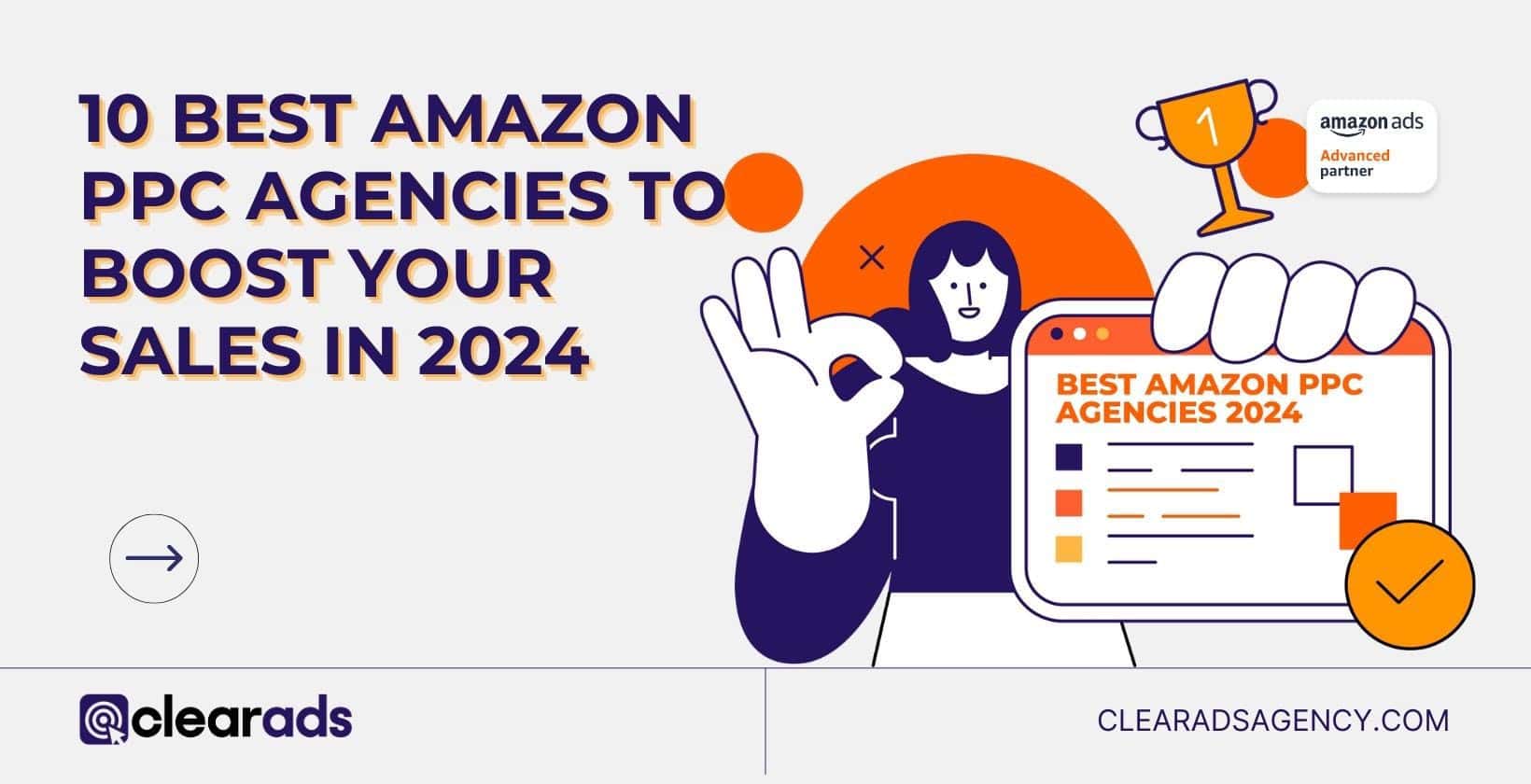The Importance of Amazon PPC Budgeting and Bidding Strategies
- Post Published:
Amazon PPC advertising is vital for brands aiming to increase visibility and sales on the platform. Effective management of PPC campaigns involves strategic decisions on budgeting, bidding, and ad placements. This article provides insights into the methods used by leading brands in their Amazon PPC strategies. It discusses the significance of flexibility, adaptability, and the use of data in optimizing bids and budgets. By understanding these principles and practices, advertisers can better navigate Amazon advertising and maximize PPC sales.
An effective Amazon PPC budget is determined by a clear understanding of business goals and key performance indicators (KPIs). Amazon bidding operates on an auction-style system, where advertisers compete for ad placements by bidding on keywords.
What Determines an Effective Amazon PPC Budget?
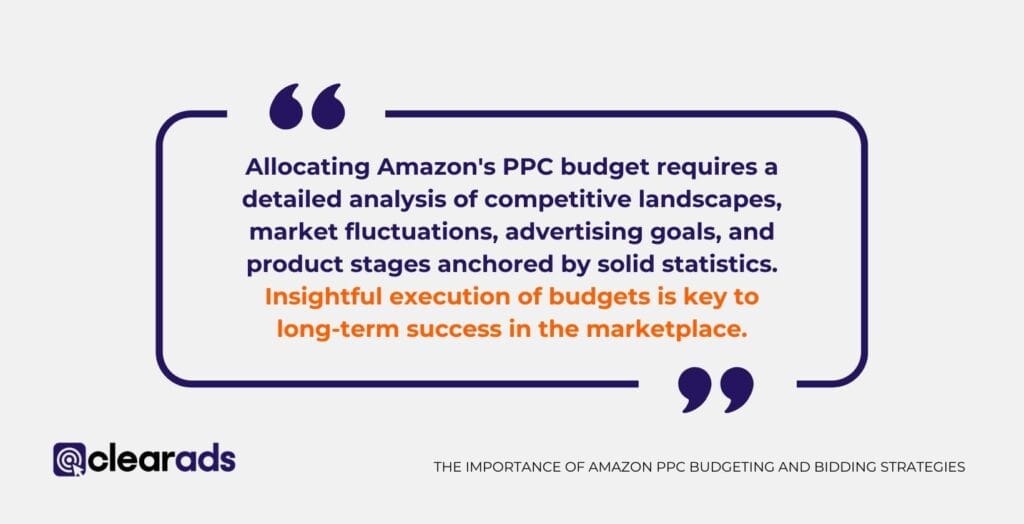
An effective Amazon PPC budget is determined by a clear understanding of business goals and key performance indicators (KPIs). Advertisers need to have a comprehensive understanding of their business objectives, whether it’s driving sales, gaining visibility, or launching a new product. Recognizing and prioritizing these goals allows for a more targeted allocation of funds.
Market research also plays a pivotal role in shaping budget allocation. Researching customer preferences, and competitor actions, provides a forecast of potential returns on advertising investment to allocate funds appropriately. For instance, a rising trend in a particular product category would require an increase in the budget allocation for ads promoting products in that category.
The 6 core principles for setting a PPC budget:
- Product Margins: Profit margins determine how much money a business is making on a product. If a product has a high-profit margin, a larger advertising budget for promotion would be justified by the return on investment (ROI).
- Competitive Landscape: The actions and strategies of competitors can significantly sway budget decisions. If a primary competitor is heavily investing in PPC ads for a similar product, a seller might need to adjust their budget to remain competitive.
- Seasonality: Certain products have seasonal demand. For example, winter apparel would see increased sales during colder months. Recognizing these patterns and understanding historical product fluctuations secure knowledge-based adjustments for PPC budgets to prevent losses.
- Market Trends: Budgeting decisions are heavily influenced by market trends. Changes in consumer behavior, often driven by societal or economic shifts, alter product demand. For example, the release of the Barbie Movie significantly increased the demand for pink products in 2023. This should be considered when determining a Christmas budget.
- Advertising Goals: Specific goals dictate budget allocations. Launching a new product requires a higher initial budget to secure a market presence. However, established products or underperformers necessitate tailored budget strategies.
- Product Lifecycle: PPC budgets vary with a product’s lifecycle. Introductory and growth stages need larger budgets for visibility while declining products see reduced budgets focused on maintaining profitability.
Allocating Amazon’s PPC budget requires a detailed analysis of competitive landscapes, market fluctuations, advertising goals, and product stages anchored by solid statistics. Insightful execution of budgets is key to long-term success in the marketplace.
How Can Sellers Strategically Allocate Their PPC Budget?
To allocate the PPC budget strategically, sellers need to factor in elements like ad relevance, campaign types, goals, and specific deal events. Strategically distributing a PPC budget is crucial for maximizing visibility and profitability on Amazon.
Keyword Focus:
A key strategy for allocating the PPC budget is to focus on high-performing keywords and products. This looks like allocating more budget to high-converting keywords that, strengthen the position of the most viable listings.
A keyword-focused strategy recognizes and reduces the budget on low-performing terms. These low-performing terms consume the budget without the ROI. Employing resources such as Amazon’s Search Term Report will identify which keywords stimulate customer engagement and sales, thus informing budget distribution choices.
Sellers may choose to allocate more budget to more relevant keywords and use a small amount of their budget for broader keywords to gain extra sales. By being conservative in split tests, advertisers ensure there is limited waste of their advertising budget and identify conversion possibilities.
Diversification:
Instead of allocating the available budget to one avenue, sellers should distribute funds among various campaigns. They should allocate a budget for all 3 campaign types (Sponsored Product, Sponsored Brand & Sponsored Display), and test different Dynamic Bidding options. Including, a blend of exact, phrase, and broad match campaigns will allow sellers to focus on the most important keywords, and discover long-tail keywords to target.
For instance, more general campaigns may demand increased funding due to stiffer competition, while product-specific campaigns offer cost efficiency, ensuring a balanced budget distribution.
Defence Strategy:
An Amazon defense strategy is a set of tactics and measures employed by sellers or brands to protect their presence, reputation, and market share on the Amazon platform. A defense strategy is crucial in a competitive marketplace where factors like counterfeit products, aggressive competitors, and fluctuating search algorithms can pose threats.
Adopting a defensive strategy is a sensible way to allocate budget by promoting branded keywords to prevent competitors gaining ground in their niche. By doing so, sellers safeguard their brand’s visibility and secure their established position in the marketplace. This tactic has the risk of cannibiliation if a brand already has a good organic appearance.
Strategic budgeting for testing:
This method allows sellers to test various ad formats, ranging from keyword choices to bidding amounts, to determine which strategy offers the best ROI. Testing is key for any seller as certain placements for Sponsored Product campaigns may work much better than others, or a particular creative in a Sponsored Brand campaign receives more clicks than others. By doing these tests, sellers know where to allocate more budget for better conversions.
For example, running simultaneous campaigns with different keyword strategies could reveal insights about audience behavior and preferences, leading to more refined budget allocations. Though A/B testing requires an initial investment, it enhances budget efficiency in the long run by funneling resources into the most effective strategies.
Ranking Campaigns:
Ranking campaigns, designed specifically to boost organic rank, require strategic budget allocation. These aggressive campaigns aim to achieve higher visibility and, consequently, attract more clicks. By allocating a more substantial budget to them, sellers ensure they have the necessary breathing room to operate efficiently and drive the desired results. Given their objective to aggressively target keywords and achieve prominent placements, these campaigns can deplete their budgets rapidly. Hence, it’s imperative to provide them with sufficient funding to maintain their momentum.
Sales events:
Sales events, such as Prime Day or Black Friday, are peak periods when more consumers are active on Amazon. Recognizing this surge in traffic, sellers should consider increasing their budgets during these events. An augmented budget ensures that campaigns remain active and visible during these high-demand periods, capitalizing on the increased number of potential customers.
Seasonality:
Sellers should be aware of the seasonal demand patterns associated with their products. By allocating a larger portion of their budget to in-season products, they can capitalize on heightened demand and maximize sales. Conversely, during off-peak seasons, it’s important to reduce budget allocation for out-of-season products, as these are less likely to convert and will waste spend.
In summary, effective budgeting for Amazon PPC encompasses several key strategies. Sellers must prioritize spending on high-performing areas, diversify their investment to mitigate risks, and continuously engage in A/B testing to identify the most cost-effective strategies. Through these tactics, they can achieve an optimized PPC budget that enhances visibility and drives sales while maintaining cost efficiency.
Real-Time notifications for ad campaigns running low on budget
To check out the real-time budget notifications, look at the top of the Campaign Manager page. This is the page where ad campaigns are created and managed. From here, you can see at a glance which campaigns are out of budget or status is at least 80% of spend. This information should be checked regularly to ensure that you have complete control over your advertising budget and that campaigns are running efficiently.
Amazon’s algorithm suggests budget increases for ad campaigns based on past spending and projected traffic, emphasizing the need for adequate budget in manual campaigns to fully explore the potential of all targeted phrases. An initial liberal approach to budgets can unlock insights into the most effective phrases for conversion. The strategy then shifts to focusing investments on ‘hero campaigns,’ which blend higher budgets with lower ACoS for top-performing targets. A critical step before ramping up spending is to analyze and refine search phrases, considering the removal or separate management of terms that deplete budgets without driving sales. Regularly updating negative keywords is a key practice, ensuring optimal campaign efficiency and boosting performance in both organic and sponsored rankings.
Why is Analyzing Past Performance Vital for Budgeting?
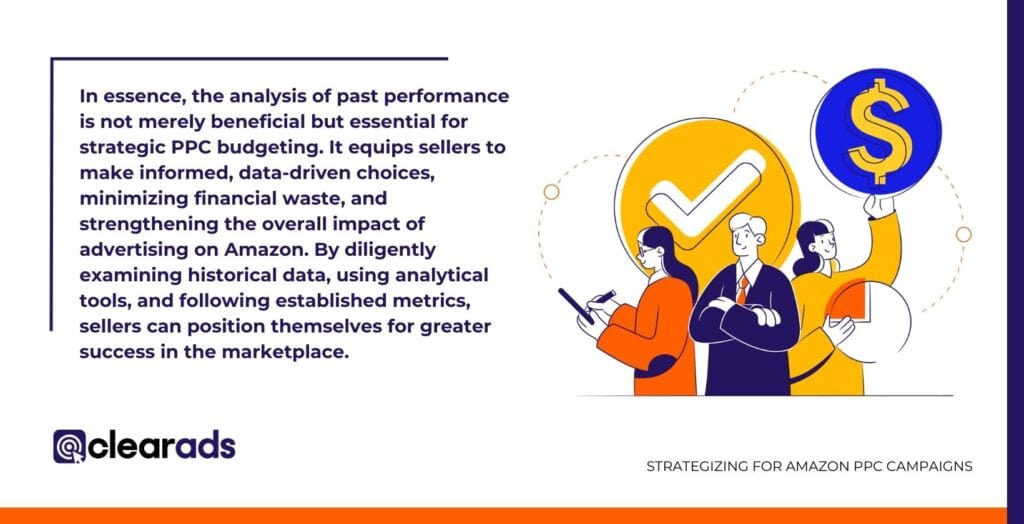
Analyzing past performance empowers sellers to make informed, data-backed decisions regarding their budgets for present and upcoming campaigns. Historical data can be assessed to predict future sales and ad success by analyzing past campaign metrics. The metrics that can be analysed include click-through rates (CTR), cost per click (CPC), advertising cost of sales (ACOS), and conversion rates. By looking at these figures, sellers gain insights into trends and patterns, helping predict how similar campaigns might fare in the future.
By reviewing past Amazon PPC campaign data, sellers can establish benchmarks for their current and future campaigns. Benchmarks prevent sellers from working in the dark but are setting tangible goals based on their proven data. For instance, if an ad for a specific product achieved a 10% conversion rate during a past sale event, that becomes the benchmark, challenging the seller to maintain or surpass it in future campaigns
Case study for assessing past performance:
Consider a seller who ran a campaign targeting the keyword “organic green tea.” Upon analyzing the past performance data, the seller observed the following:
- Profitability: The keyword “organic green tea” achieved a 15% ACOS. Such a profitable keyword might prompt a higher budget allocation in subsequent campaigns.
- Visibility: The Top of Search (TOS) impression share for this keyword was less than 5%, meaning their ad wasn’t showing up on page 1 as often as they’d like. This low visibility rate could prompt a seller to add a TOS Modifer to their campaign.
- Conversion: The conversion rate for the keyword was at a healthy 5%. A high conversion rate indicates that not only were users clicking on the ad, but they were also making a purchase, further validating the decision to allocate a larger budget to this keyword.
In essence, the analysis of past performance is not merely beneficial but essential for strategic PPC budgeting. It equips sellers to make informed, data-driven choices, minimizing financial waste, and strengthening the overall impact of advertising on Amazon. By diligently examining historical data, using analytical tools, and following established metrics, sellers can position themselves for greater success in the marketplace.
So,How Much Should You Spend on Amazon Advertising?
Sellers should be spending a maximum of 35% of their ad revenue on Amazon advertising, whilst taking into consideration their overall profitability. Determining the appropriate amount to spend on Amazon advertising requires considering industry benchmarks, specific business variables, and the distinct needs of products at different stages in their lifecycle. Sellers need to evaluate their current operational size, as larger-scale businesses have greater budgets to play with. The product category should also be considered, as certain niches face stiffer competition and higher CPCs, requiring higher advertising expenses. Items with higher profit margins will allow for increased advertising expenditure, while lower-margin items demand cost-effective spending strategies.
New listings demand higher advertising investment to achieve market presence, compelling sellers to absorb initial losses for future market position stability. This initial investment is essential to gain visibility, traction, and initial customer reviews. Sellers might allocate a larger portion of their budget here, sometimes even accepting initial losses (often referred to as the cost of acquisition) to establish a market foothold.
Start new listings with a daily budget of $10-20 to test the waters, and then increase or decrease according to their business needs. This will prevent the risk of significantly overspending while providing a basis to assess campaign performance. For example, advertisers may choose to increase the daily budget after a week to increase their reach.
The daily budget for listings with a history of sales and reviews depends on the profitability of the campaign. Advertising spend can be greater if sellers are confident that this campaign will perform well and will consistently bring in profitable sales. There is often a fear of having a higher ACOS as it means businesses are spending more, but if it remains profitable it is not always negative.
How Does Amazon Bidding Function and Why is it Essential?
Amazon bidding operates on an auction-style system, where advertisers compete for ad placements by bidding on keywords. Amazon bidding determines when and where ads will be displayed. The highest bidder in most CPC auctions pays only $0.01 more than the second-highest bidder. This function is essential for advertisers because it directly impacts an ad’s visibility in the search results and the likelihood of generating clicks and conversions. Sellers win the auction by having the highest bid, by strategically setting bids, they can optimize their advertising budget for maximum ROI.
When a user searches for a product on Amazon, the platform conducts an instantaneous auction among ads relevant to that search query. However, the highest bidder doesn’t always secure the top ad placement. Amazon considers several factors, including the bid amount and the ad’s relevance to the search query, to decide which ad to display.
This system has two main implications. First, it dictates product visibility; ads with better bids and relevance achieve prime spots, enhancing exposure in Amazon’s competitive space, where visibility often equates to sales. Second, while high bids can offer better placement, they increase advertising expenses. Sellers must balance aggressive bidding with maintaining profit margins.
Amazon puts the customer experience first, so it wants to show them a product that they think will convert – which is why excessive bidding won’t always work to get top ad placements depending on the target keywords/product/category. For instance, even if Advertiser A bids higher than Advertiser B, if Advertiser B’s product is deemed more relevant to the user’s query, it might secure a better ad placement
Bidding is pivotal for 4 reasons:
- Visibility: higher bids will ensure your product ad is displayed prominently, which significantly increases its visibility. The more visible an ad, the higher the chances of it being clicked on, leading to potential sales.
- Control Over Ad Spend: bidding allows advertisers to set a maximum budget they’re willing to spend on an ad click. This ensures that they don’t exceed their advertising budget and prevents the campaign from pausing prematurely.
- Targeting the Right Audience: the bidding system, combined with Amazon’s ad targeting mechanisms, ensures that ads reach the most relevant audience. For example, sellers can target potential customers who have clicked on their ads but haven’t purchased via Sponsored Display.
- Competitive Edge: Given the vast number of sellers on Amazon, bidding can provide a competitive advantage. By placing the right bid, sellers can outperform competitors and secure prime ad real estate on search results or product pages.
Amazon’s bidding process is crucial for effective advertising on the platform. Understanding its workings, acknowledging its role in enhancing visibility and profitability, and utilizing competitive bidding strategies are key for sellers. Engaging adeptly with this system is vital for businesses striving to differentiate themselves and attract consumer interest in Amazon’s expansive marketplace.
What Differentiates Manual and Automated Bidding?
- Efficiency: Saves time by automatically adjusting bids.
- Data-driven: Uses Amazon’s algorithms and vast data to set bids.
- Consistency: Ensures bids are always active and adjusted without manual intervention.
- Adaptable: Can quickly respond to changes in the marketplace.
Manual bidding:
Cons
- Less Control: Can’t make nuanced decisions based on specific insights.
- Over-reliance: Might miss out on opportunities that require human intuition.
- Potential Overspend: Might place bids in high competition or irrelevant areas, leading to higher costs.
- Lack of Transparency: Not always clear why certain bid decisions are made.
Pros
- Flexibility: Can make immediate changes based on personal insights.
- Transparency: Sellers know exactly why each bid decision is made.
- Strategic: Can implement specific strategies for certain products or events.
Cons
- Potential for Error: Human error can lead to missed opportunities or overspending.
- Option overload: Sellers have many different ways to tailor their campaigns, which can be confusing for beginners.
- Inconsistency: Might forget or miss out on adjusting bids, leading to suboptimal performance.
Hybrid strategies are a good way of utilizing both ad types. This involves starting with automated bidding to gather data and switching to manual bidding for refined optimization. Recognizing the distinctive features and implications of both methods enables sellers to harness their benefits effectively, tailoring their approach to meet the nuanced demands of their campaigns.
How Do Dynamic Bidding Strategies Vary and Which is Optimal?
Dynamic bidding on Amazon consists of three primary strategies: “dynamic bids – down only,” “dynamic bids – up and down,” and “fixed bids.” Each variation serves a different purpose and is tailored toward different campaign objectives. For instance,’ Dynamic Down Only’ could be classed as a more conservative approach than ‘Fixed bids’.
- 3 Bid Types:
Dynamic Down Only: Amazon decreases bids in real-time for ad placements deemed less likely to result in a sale. - Dynamic Up & Down: Amazon adjusts bids in real-time, raising them for high-conversion opportunities and lowering them for low-conversion chances.
- Fixed Bids: Advertisers set a specific bid amount that Amazon maintains consistently for ad placements.
Determining the most optimal bidding strategy depends on the specific goals set by the seller. For instance, a seller aiming for maximum visibility and brand awareness might prioritize more aggressive bidding strategies (Dynamic Up & Down) that ensure top ad placements, regardless of immediate conversion rates. On the other hand, a seller with a primary goal of cost efficiency, especially in a competitive niche, might lean more towards the Down Only strategy to minimize expenses on less promising clicks. It’s essential to align the bidding approach with the overarching objectives of the advertising campaign to achieve desired outcomes effectively.
What is Dynamic Bidding: Down Only?
Dynamic Down Only bidding is where bids are decreased in real-time when the ad is less likely to convert. A dynamic bidding approach ensures that advertisers don’t overpay for clicks that have a lower probability of leading to a sale. The system uses historical data and its algorithms to predict conversion probabilities. If the algorithm determines that a particular ad placement or search query has a lower chance of converting, it will proportionally reduce the bid for that specific auction.
- Use cases for Down Only bidding:
High Competition Niches: In product categories or niches where there’s intense competition, the Down Only strategy can be more cost-effective. The bid types prevents overspend on high-competition keywords that might not guarantee conversions. - Limited Budget Campaigns: For advertisers with a tight budget, this strategy ensures that funds are not wasted on less promising ad placements.
- New Product Launches: When introducing a new product to the market, there might be uncertainties regarding which keywords or placements will perform best.
Drawbacks to this approach:
- Restricts potential sales: While the strategy aids in preventing overspending on less promising clicks, it also restricts the ability to benefit from potential sales, possibly resulting in revenue loss.
- Reduced visibility and missed opportunities: Dynamic Down Only bids might result in reduced visibility and missed opportunities, as the strategy does not counteract competitors’ aggressive bidding tactics.
This approach might not be suitable for product launches or campaigns aiming to quickly gain market share, as it restrains the campaign’s reach potential by not engaging in higher-cost, higher-competition auctions. Sellers must weigh these factors against their market conditions and campaign goals before opting for the Down Only strategy.
When is Dynamic Bidding: Up and Down More Beneficial?
Dynamic Up and Down bidding is particularly beneficial in scenarios where competitive visibility is crucial, such as product launches or high-demand products. Dynamic up-and-down bidding uses ad performance to adjust bids in real-time. The bids will increase for opportunities that seem more likely to convert or decrease for those less likely.
This strategy can be more beneficial than Down Only as it capitalizes on high-converting opportunities. While the Down Only approach focuses on cost-saving by reducing the bid for less likely conversions, Up and Down bidding actively seeks to exploit every potential sale.
Dynamic up-and-down bidding can aggressively pursue top ad placement during peak periods to increase visibility and sales. When the probability of conversions is high, this strategy allows sellers to outbid competitors, gaining increased market share and visibility. This approach could lead to a higher ROAS, especially in these high-stakes scenarios.
However, there is risk-reward balance with this strategy. By allowing bids to increase, sellers risk significantly increasing their ACOS if the expected conversions do not materialize.
Use case of Up and Down bidding:
Background: A seller is introducing a new fitness tracker on Amazon, which has unique features not present in most of the current market offerings. Given the innovative nature of the product, there’s a potential for high demand, but there’s also significant competition from established brands.
Implementation:
- Pre-launch Phase: The seller starts with comprehensive keyword research to identify high-value keywords related to fitness trackers and their unique features.
- Launch Phase: As the product goes live, the seller employs the Dynamic Up and Down bidding strategy. This ensures that for search terms where the product ad is more likely to convert (e.g., “innovative fitness tracker with sleep analysis”), the bid is increased to gain top ad placement. Conversely, for more generic terms where the conversion likelihood might be lower due to competition (e.g., “fitness tracker”), the bid might be decreased to save on costs.
- Post-launch Analysis: The seller monitors the performance closely. They notice that the ad placements for their targeted high-value keywords are consistently at the top, leading to increased visibility and sales. The aggressive bidding for these terms has allowed them to outperform competitors in terms of ad placement.
Outcome: The Dynamic up-and-down bidding strategy enables the seller to maximize visibility during the crucial launch phase. The product gains traction quickly due to its increased visibility for high-converting terms. The seller achieves a higher RoAS, and the product establishes itself as a notable contender in the fitness tracker category.
Note: While the strategy proves beneficial in this scenario, the seller is constantly monitoring the ACOS to ensure that the increased bids are justified by the conversion rates.
How can Amazon sellers calculate the optimal bid per keyword?
Amazon sellers can calculate the optimal bid for a keyword by assessing its value concerning campaign objectives and using specific formulas. Firstly, it’s important to understand keyword value. This value is determined by several factors including its historical performance, relevance to the product, and potential to drive conversions.
For instance, a keyword that consistently leads to sales would hold a higher value than one that only garners clicks without conversions and here sellers can base how aggressively they want to bid.
Maximum Bid Formula:
Maximum Bid = Product Margin × Conversion Rate
Exemplar scenario:
Product Price: $50
Product Margin: $20 (40% of the product price)
Conversion Rate: 5%
$20×0.05=$1.00
Optimal Bid Formula:
Optimal Bid = Target ACOS × Product Price × Conversion Rate
Exemplar scenario:
Target ACOS: 25%
Product Price: $50
Conversion Rate: 5%
0.25 × $50 × 0.05 = 0.62
Keyword Relevancy Score Method:
To further refine their bidding strategy, sellers can assign a relevancy score to each keyword based on its significance to the product. This score, typically on a scale from 1 to 10 (with 10 being the most relevant), can be multiplied by the keyword’s search volume to prioritize bidding.
Formula: Priority Score = Keyword Relevancy Score × Search Volume
Note: There can be discrepancies in this method, for example when a less relevant keyword has an extremely high search volume and a low relevancy score in a very niche category then it could still achieve a high priority score.
Example:
Keyword
Running Shoes
Jogging Gear
Sports Shoes
Footwear
Relevancy
9
7
8
5
Search Volume
10,000
8,000
6,000
12,000
Priority Score
90,000
56,000
48,000
60,000
In this scenario, even though “Footwear” has a higher search volume, its relevancy score is lower than “Jogging Gear”. As a result, “Jogging Gear” has a lower priority score compared to “Footwear”. Sellers would then need to consider other factors, like historical performance, to decide on bidding aggressiveness for “Jogging Gear”. However, “Running Shoes”, which has the highest priority score, indicates a need for more aggressive bidding compared to the other keywords.
When Should Sellers Consider Using Fixed Bids?
Fixed bids should be used when the goal is consistent ad placements and a clear understanding of a product’s value proposition. Fixed bids refer to a predetermined amount set by the seller for a keyword or ad placement. This bidding strategy ensures that the bid remains constant, irrespective of the auction dynamics or keyword competition. It provides sellers with a greater level of predictability and control over their advertising costs.
When are fixed bids are most appropriate:
- Product Launches: During the initial stages of a product launch, sellers might have a predetermined budget and a set target for visibility. Fixed bids can ensure consistent ad placements during this critical phase.
- Predictable Sales Seasons: For products that have consistent sales patterns, like seasonal items, fixed bids can be beneficial. If a seller knows that their product sells best during a particular time frame, they can set a fixed bid to maintain visibility during that period.
- Competitive Landscapes: In niches where the competition is fierce and bid amounts fluctuate frequently, setting a fixed bid can provide stability and prevent overspending.
- Budget Control: For sellers with a tight advertising budget, fixed bids offer a way to ensure they do not exceed their spending limits.
As an overview, fixed bids allow sellers to set an exact bidding amount to achieve the necessary placements, without deviating from the initial bid price. It can be used in both aggressive and conservative strategies depending on the seller’s goals.
How Can Rule-Based Bidding Customize Your PPC Strategy?
Rule-based bidding allows advertisers to set custom criteria for their bids in Amazon PPC campaigns. Rule-based bidding involves defining specific conditions or “rules” under which bids will be adjusted, either up or down. By leveraging this strategy, sellers can automate the bid optimization process, ensuring that their ads perform at their best without constant manual adjustments.
Rule-Based Bidding’s Customization Options:
- Rule-based bidding: Utilizes if-then scenarios for bid adjustments. If a keyword underperforms, its bid decreases, and if it excels, the bid rises in real-time.
- Customization scope: Sellers can tailor rules at the campaign, ad group, or keyword level, ensuring PPC strategies align with specific product performance.
Setting Up Rules: Key Considerations and Common Practices:
- Defining objectives: Sellers should pinpoint their goals, such as higher visibility or improved ACOS, which guide rule creation.
- Selecting metrics: Rules often involve metrics like CTR, conversion rates, and ACOS, aligned with campaign objectives.
- Rule parameters and frequency: Determine rule evaluation frequency, balancing between over-adjustment and missing optimization chances.
- Safety measures: Set safeguards, such as bid caps and keyword filters, to avoid excessive changes and undue costs.
Here are some of the primary benefits of integrating custom rules into your PPC strategy:
- Precision and Relevance: Rule-based bidding offers granularity. If a keyword exceeds a set conversion rate, its bid can automatically increase, prioritizing high-performing keywords.
- Budget Efficiency: Rules can auto-decrease bids for lagging keywords or placements, preventing wasteful spending. For instance, if a keyword’s ACOS goes beyond a set mark, its bid drops.
- Time-saving: Proper rules reduce the frequency of manual tweaks. This automation benefits those with large product ranges or multiple campaigns.
- Flexibility: Advertisers can form rules using metrics like click-through rates and sales, ensuring alignment with business objectives and KPIs.
- Dynamic Market Response: Rule-based bidding adapts to e-commerce’s swift market shifts. During high-demand periods, rules can push for top ad placements, guaranteeing visibility.
Rule-based bidding presents a sophisticated approach for sellers aiming to leverage Amazon’s PPC capabilities to the fullest. While it requires an initial investment of time and thought in setting up the rules, the automation and customization pay off by consistently working towards the seller’s specific objectives even as the market evolves. This strategy, combined with careful monitoring and periodic reassessment of rules, stands as a robust method for achieving and sustaining advertising success on Amazon.
What are the Key Rules and Parameters in Rule-Based Bidding?
4 Commonly applied rules and their expected outcomes:
- Bid Increase for High Performers: A common strategy is to raise bids for keywords showing high conversion rates or sustaining a profitable ACOS. This tactic aims to leverage confirmed successful keywords to potentially boost visibility and sales.
- Decrease Bids for Low Performers: Conversely, a common rule is to decrease bids for keywords that have low conversion rates or those driving up the ACOS without a corresponding increase in sales. This approach helps minimize unproductive ad spend, redirecting resources more efficiently.
- Pausing Non-Performers: Sellers often set rules to pause keywords/ad groups that fail to generate any sales after a certain number of impressions or clicks. This prevents wasted spend on areas unlikely to convert, enhancing overall campaign profitability.
- Targeted Positioning: Some rules aim to maintain ad positions within a specific range (e.g., top of search results), adjusting bids to sustain this strategic placement. The goal is enhanced visibility, which often leads to increased click-through rates and potential sales.
Realistic and strategic parameters for rules:
- Setting Bid Ceilings and Floors: Establishing maximum and minimum bid amounts prevents rules from making extreme adjustments that could exhaust your budget rapidly or make your ads non-competitive.
- Performance Thresholds: It’s critical to set realistic performance thresholds for rules. For instance, expecting a 10% conversion rate in a niche where 3% is the average invites disappointment and unnecessary adjustments.
- Delay in Effect: Rules should account for the natural delay between clicks and conversions. Instantaneous reactions to short-term performance dips or spikes can lead to overcorrection, instability, and inefficiency in ad campaigns.
- Data-driven Decisions: Bidding rules must be grounded in accurate, comprehensive data. Utilizing insufficient data can lead to misinformed decisions, highlighting the importance of a well-integrated analytics system.
Amazon requires an understanding of the fundamental rules that sellers frequently apply, the realistic parameters that guide these rules, and the strategic foresight to avoid common pitfalls.
Why are ACOS and TACOS Key Metrics in Bidding Decisions?
ACOS (Advertising Cost of Sale) and TACOS (Total Advertising Cost of Sale) directly measure the effectiveness and profitability of advertising campaigns and overall account performance. understanding these metrics enables sellers to make strategic bidding decisions during seasonal fluctuations, promotional periods, or market shifts. They can allocate budget effectively, calibrate bids in real-time, and anticipate the need for strategic adjustments to sustain growth momentum.
Definitions and Differences between ACOS and TACOS:
ACOS: This is the ratio of ad spend to targeted sales, calculated by dividing the total spend on advertising by the revenue generated from these ads. ACOS is expressed as a percentage, where a lower ACOS indicates higher profitability from an advertising perspective.
Calculation: ACOS = (Ad Spend / Sales from Ads) x 100
Example:
- Total Ad Spend = $200
- Sales from Ads = $1000
Calculation: (200/1000) x 100 = 20%
ACOS: 20%
TACOS: While ACOS focuses on the relationship between ad spend and ad-generated revenue, TACOS takes a broader approach. TACOS factors in the total revenue—both organic and ad-driven—relative to the advertising spend. By dividing the total ad spend by the overall revenue, sellers gain insight into how advertising impacts the entire business performance, not just isolated campaign success.
Calculation: TACOS = (Total Ad Spend / Total Sales) x 100
Example:
- Total Ad Spend = $200
- Total Sales = $1500
Calculation: (200/1500) x 100 = 13.33%
TACOS: 13.33%
The key differences between ACOS and TACOS lie in their scope; ACOS is more narrow and campaign-specific, while TACOS provides a holistic view of advertising’s influence on overall sales. Understanding this distinction is crucial for sellers aiming to balance attracting new customers and retaining current ones through organic engagement.
Interpretation of These Metrics for Bidding Strategy Refinement:
A deep dive into ACOS can help sellers optimize bids for profitability on a campaign level. An optimal ACOS can differ based on various factors such as competition, product lifecycle, and profit margins. For instance, a new product launch might initially tolerate a higher ACOS to gain market traction, whereas established products would aim for a lower ACOS to maximize profit. Depending on the product stage, sellers would adjust bids according to how aggressively they want to bid.
TACOS, on the other hand, serves as an indicator of overall business health. A decreasing TACOS in a growing business could indicate effective ad spend, signifying that the increased investment in advertising is leading to proportionally higher total revenue. Conversely, if TACOS rises and overall revenue remains stagnant or decreases, it could signal over-dependence on paid campaigns, necessitating a reevaluation of the bidding strategy.
How Can Sellers Optimize Bids Based on Ad Placements?
To optimize bids based on ad placements, sellers can employ placement modifiers in tandem with the appropriate bidding type, customizing this approach for each campaign type. The placement modifier strategy involves setting varied bid amounts for distinct advertisement positions on Amazon’s platform. This ensures optimal visibility for products and potentially boosting click-through rates and conversions.
Ad placements for Amazon PPC are split into three sections Top of Search, Product Pages, and Rest of Search. These placements are strategically positioned to optimize visibility and drive conversions, catering to users at various stages of their shopping journey, and can look different for each campaign type.
Optimizing bids based on placement modifiers:
- Top of Search Bidding:
- Aim: Capture the prime positions in Amazon search results, known for maximum visibility.
- Method: Sellers employ higher bid modifiers to prioritize their ads at the search’s top, crucial for products in competitive niches.
- Product Detail Page Bidding:
- Aim: Feature products on detail pages, often adjacent to competitor products.
- Method: Adjusting bid modifiers for these specific placements targets customers in the decision-making stage, allowing for direct product comparisons.
- Rest of Search Bidding:
- Aim: Gain visibility without necessarily being at the top of search results.
- Method: Sellers use reduced bid modifiers to position ads mid-way or towards the end of search results, ideal for niche targeting or budget constraints, yet ensuring notable visibility.
Below is an image of how you can adjust the campaign manager for a Sponsored Product Campaign:

Using placement modifiers, whilst also understanding Amazon’s dynamic bidding allows sellers to optimize and manipulate their campaigns to achieve more targeted ad placements, thereby increasing visibility and in some cases sales.
Bidding Strategy Examples:
The strategies below are just examples and aren’t recommendations for you to do in your campaign. The examples below are only relevant for Sponsored Product Campaigns.
Aggressive Launch Strategy
Bids: $2
Bid type: Dynamic Up & Down or Fixed Bids.
Modifier: 250% for Top of Search
Rationale: Suitable for new product launches, aiming for maximum visibility to gain initial reviews and traction
Defensive Strategy
Bids: $1.20
Bid type: Dynamic Down
Modifier: No Modifiers
Rationale: Ideal for products with established brand presence, focusing on maintaining rank without overspending.
Niche Product Strategy
Bids: $0.80
Bid type: Fixed
Modifier: 150% on Top of Search
Rationale: Targeting a specific audience segment with unique products, aiming to stand out at the top of searches.
Budget-Conscious Strategy
Bids: $0.60
Bid type: Fixed
Modifier: No additional modifiers
Rationale: Suitable for sellers with tight budgets, focusing on getting consistent visibility without overspending.
The chosen strategy hinges on a product’s sales history and the seller’s campaign objectives. For ranking or launch campaigns, a more aggressive approach may be warranted, even if it leads to a higher ACOS. Conversely, post-launch, a budget-conscious or defensive strategy might be more prudent for some campaigns. It’s advisable to maintain multiple campaigns employing diverse strategies to discern what works best for the business.
Regarding Sponsored Brand and Sponsored Display, they involve distinct settings and optimization methods for ad placement. As of the current date, dynamic bidding and placement modifiers can’t be utilized for Sponsored Brand campaigns. Nevertheless, sellers can adjust bids for non-top-search ad placements.
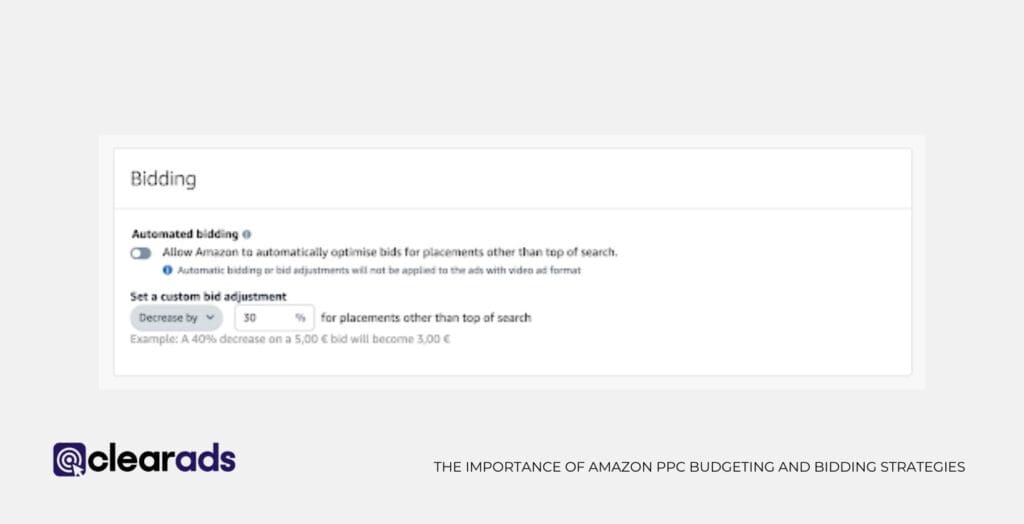
Moreover, Sponsored Display ads do not show up on the Search Engine Results Page (SERP), but show up on product detail pages, Amazon’s home page, and third-party websites. The goal is usually to reach a particular type of audience to: retarget customers, cross-sell products, expand reach beyond Amazon NS boost brand awareness.
What are the Top Ad Placements and Their Significance?
Anything on page one of the SERP is deemed as ‘top of search’ and are pivotal for gaining maximum visibility and achieving a competitive edge in the digital marketplace.Top of search includes the products marked with a black box (Sponsored Product placements) & a red box (Sponsored Brand placements). Securing the prime position can lead to higher CTR, increased conversion rates, and optimized ROAS, making it a key focus for advertisers aiming to maximize their PPC campaign’s effectiveness.
By targeting top ad placement, sellers influence Amazon’s algorithm to increase their organic ranking, and decrease their overall TACOS.
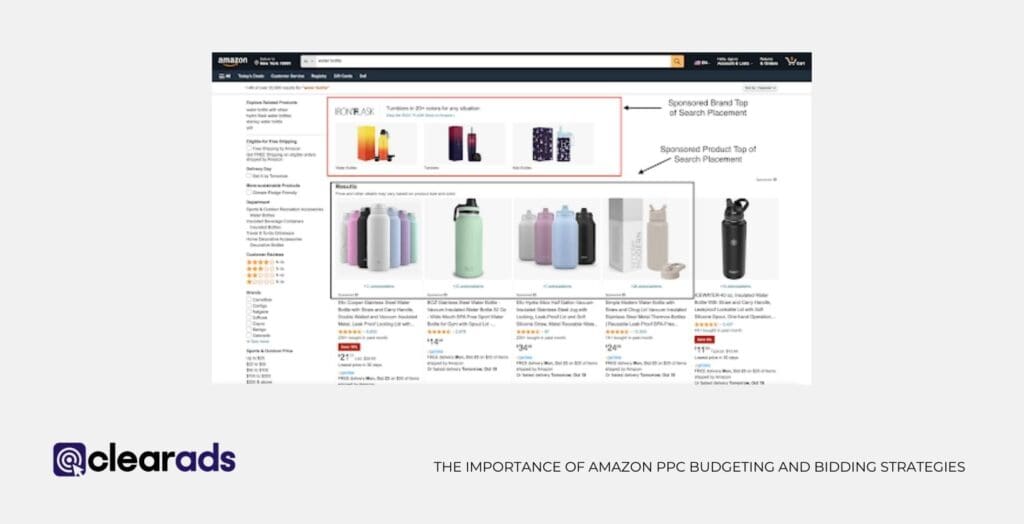
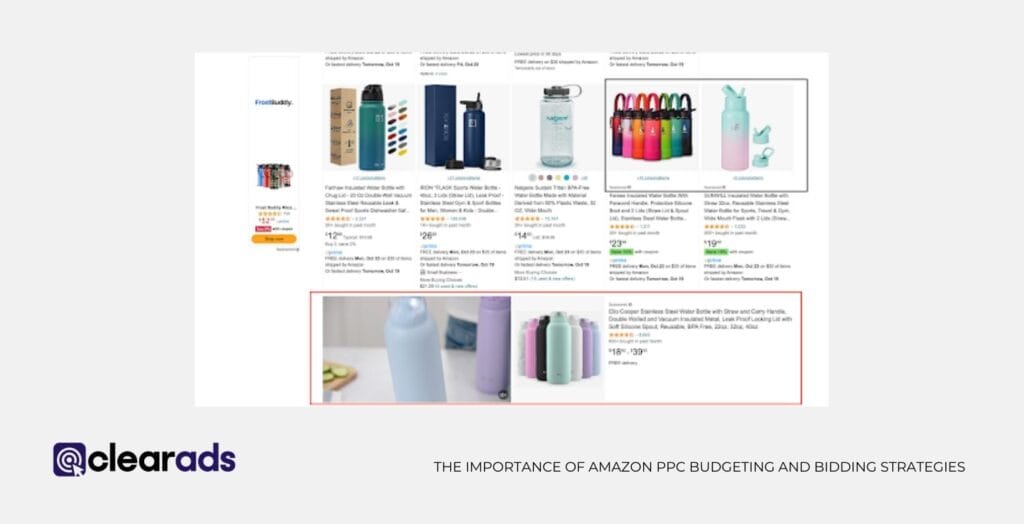
Product Pages:
Directly beneath the listing, there are Sponsored display ads.
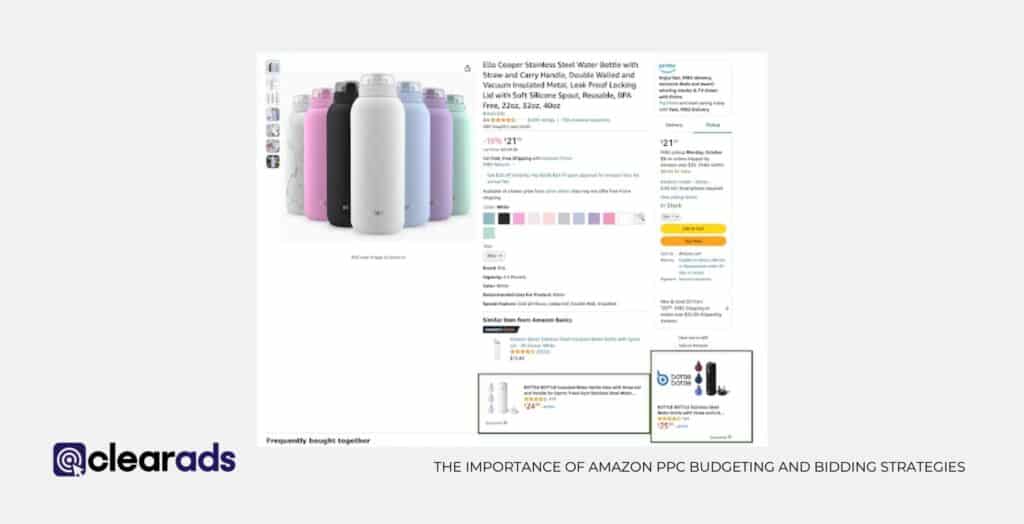
Further below you can find Sponsored Product ad placements.
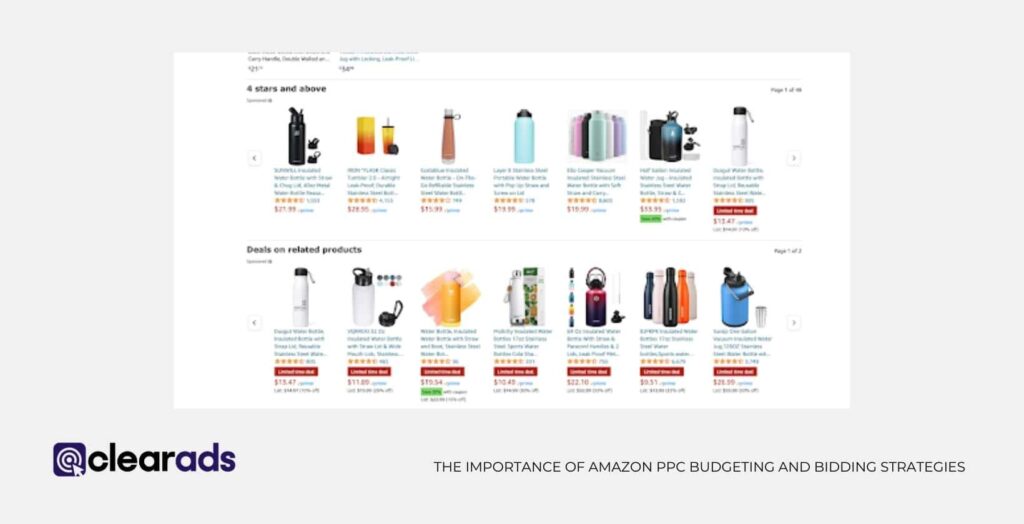
In some cases, you can also find Sponsored Brand ads just above the comment section. Here is an example of how this looks:
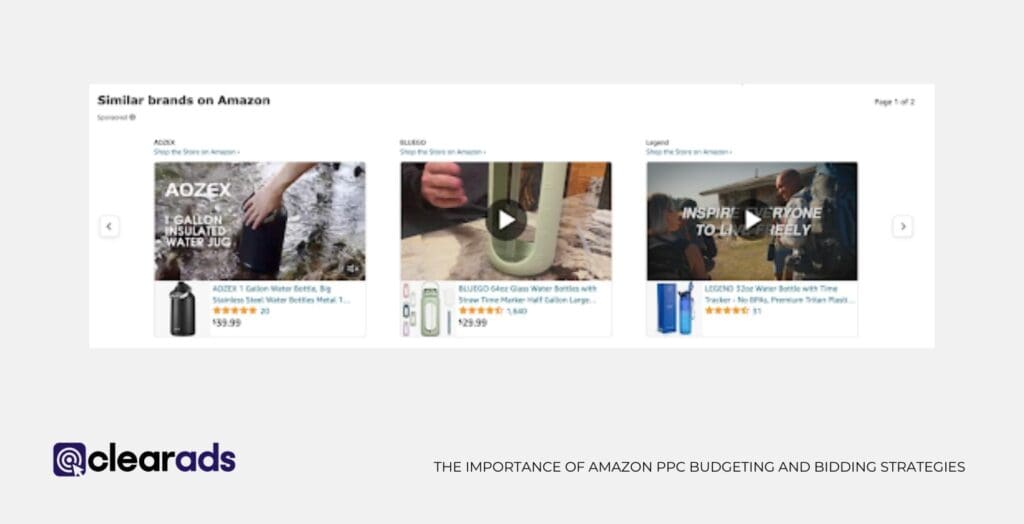
However, being overly aggressive on certain keywords can result in paying a premium for clicks that may not necessarily convert to sales. Additionally, without careful monitoring, an aggressive approach can cause advertisers to overspend on non-performing ads, diminishing the overall return on ad spend (ROAS). Constantly chasing top ad placement is not always advantageous when considering price, product quality, and reviews, product quality and so constantly optimizing their campaigns allows them to not risk overspending.
How are Modern Technologies Reshaping Amazon's Bidding Strategies?
Modern technologies automate bidding strategies in a data-driven manner. These advanced technologies facilitate more sophisticated, data-driven decisions, altering the landscape of online advertising strategies. They can offer a range of different features, such as day parting, and in-real time bid adjustments based on set rules, and also provide data for sellers to refer to.
AI and Machine Learning in Bid Optimization:
- Automated Bidding Decisions: Instead of manually analyzing vast amounts of data, sellers now leverage AI algorithms that automatically adjust bids in real time. These systems process historical data and performance metrics at scale, often leading to more accurate bidding decisions that can improve the efficiency of ad spend based on the rules sellers set.
- Pattern Detection and Data Interpretation: Machine learning technologies identify complex patterns within large datasets that would be impossible for a human to analyze quickly. By recognizing these trends, these systems can forecast optimal bids for products based on similar items’ past performance, seasonal changes, or market trends.
- Performance Improvement Over Time: One of the most significant benefits of machine learning is its ability to learn continuously from new data. As it ingests performance information from bidding strategies, it refines its algorithms, for more precise bidding strategies and higher ROI.
Predictive Analytics and Customer Behavior Modeling:
- Behavioral Forecasting: Modern tools can predict customer behavior by analyzing browsing patterns, purchasing history, and product preferences. This insight allows for more targeted bidding strategies, by bidding higher on products likely to convert.
- Demand Prediction: Utilizing machine learning, systems can now more accurately predict product demand shifts, helping sellers adjust their bids proactively. This aspect is particularly crucial for inventory management and helps avoid overspending on ads for out-of-stock items.
- Price Optimization: AI-driven price optimization models enable sellers to dynamically adjust product prices based on market conditions, competition, and consumer behavior insights. This direct integration with bidding strategies ensures that advertisements are always promoting the price point most likely to drive conversions.
By using these tools, sellers can anticipate and adapt to market changes more swiftly and accurately, securing a competitive edge in an increasingly crowded marketplace. However, staying abreast of emerging trends and potential regulatory changes will be crucial for leveraging these technologies effectively and ethically.
Which PPC Tools are Crucial for Efficient Bid Management on Amazon?
For effective bid management, sellers need tools that can do keyword research, data analytics, bid management, and perform page performance reviews. These features ensure the most informed and effective bid management.
Identifying relevant and high-performing keywords tailored to Amazon shoppers allows sellers to form the foundation strategy for their PPC strategy. The capability to craft and manage compelling ads ensures optimal visibility within the marketplace. Data analytics provides insights into campaign performance, while bid management optimizes ad spend for the best returns. Monitoring competitors on Amazon is crucial to gauge market position and identify strategic opportunities. Tools that assess landing page performance, especially for product listings, are essential in enhancing conversion rates.
Many Amazon PPC tools and software offer a combination of these functionalities, streamlining the advertising process on the platform.
Top-Rated Tools for PPC:
- Helium10:
- Features: Comprehensive suite that includes keyword tracking, listing optimization, and competitor analysis.
- Benefits: Streamlines multiple Amazon seller tasks within one platform, allowing sellers to gather keywords, search volume, and competitor knowledge for their campaigns.
- Seller App:
- Features: Provides real-time data analytics, keyword tracking, and profitability analysis. Its PPC analyzer helps pinpoint profitable keywords and ad groups.
- Benefits: Enhances ad performance through actionable insights and offers extensive product research capabilities.
- Zon.Tools:
- Features: Employs automation algorithms to manage campaigns. Offers features like automated campaigns, Target ACOS bidding, and 24/7 bid adjustments.
- Benefits: Reduces manual intervention through its automated processes, enabling sellers to achieve desired ACOS with minimal effort.
- Teikametrics:
- Features: Uses AI to provide insights into ad placements, keyword bids, and product targeting. Integrates both Sponsored Products and Sponsored Brands.
- Benefits: Offers a Flywheel platform that connects advertising data to inventory, ensuring optimal stock levels and bid management.
- Perpetua:
- Features: Focuses on goal-driven automation, offering ad strategies based on objectives. Integrates with Amazon DSP (Demand-Side Platform) for a broader advertising scope.
- Benefits: Simplifies campaign structures, provides AI-powered suggestions, and offers granular reporting for in-depth analysis.
- Ad Badger:
- Features: Provides tools specifically for Amazon, like bid optimization, negative keyword tooling, and dayparting (hourly bid adjustments).
- Benefits: Offers a straightforward interface with rapid campaign adjustments and emphasizes a community approach with its educational resources.
By minimizing the necessity for frequent manual adjustments, sellers can devote more attention to overarching business strategies. Additionally, the enhanced performance of campaigns and elevated conversion rates directly contribute to heightened sales and profitability, often outweighing the operational costs of these tools. While each tool brings distinctive functionalities, their shared objective is to automate intricate processes, furnish valuable insights, and ultimately amplify the profitability of PPC campaigns.
- Other tools available:
- Jungle Scout
- Data Dive
- BidX
- Adherence
Sellers should conduct thorough research to ascertain which tools align best with their objectives and budget.
How are Leading Brands Adapting Their Bidding Strategies on Amazon?
Leading brands are increasingly leveraging data-driven insights and embracing flexibility to adapt their bidding strategies on Amazon.
What do big brands do?
- Flexibility and Adaptability: The Amazon marketplace is always changing due to shifting competition, changing customer tastes, and updates to its system. Successful brands are flexible, adjusting their bidding tactics based on current market trends and detailed performance data.
- Data-Driven Decision Making: Top sellers on Amazon harness the power of comprehensive data analytics. They analyze metrics such as click-through rates, conversion rates, and ACOS to make informed decisions about bid adjustments. This allows them to allocate their budgets more effectively and achieve better ROI.
- Adaptive Bidding: Instead of sticking to a single bidding strategy, successful brands often shift between manual and automated bidding based on campaign performance. For instance, a brand might start with manual bidding to test the waters and then switch to automated bidding once they have sufficient data on keyword performance.
- Embracing New Features: Amazon frequently rolls out new features and tools related to PPC advertising. Leading brands stay updated and quickly incorporate these features into their bidding strategies. An example includes the introduction of placement bidding, which allows advertisers to modify bids based on where the ad appears on Amazon.
- Diversification: Recognizing that not all products or campaigns perform equally, top brands diversify their bidding strategies. They might allocate more budget to high-performing products while reducing bids for products that aren’t converting as expected.
- Seasonal Adjustments: Brands that have been on the platform for a while understand the seasonality of their products. They adjust their bids during peak seasons or promotional periods like Prime Day to maximize visibility and sales.
In summary, leading brands on Amazon excel by strategically leveraging data analytics, adapting rapidly to platform changes, and maintaining flexibility in their bidding approaches.
Why is Continuous Optimization the Key to PPC Success on Amazon?
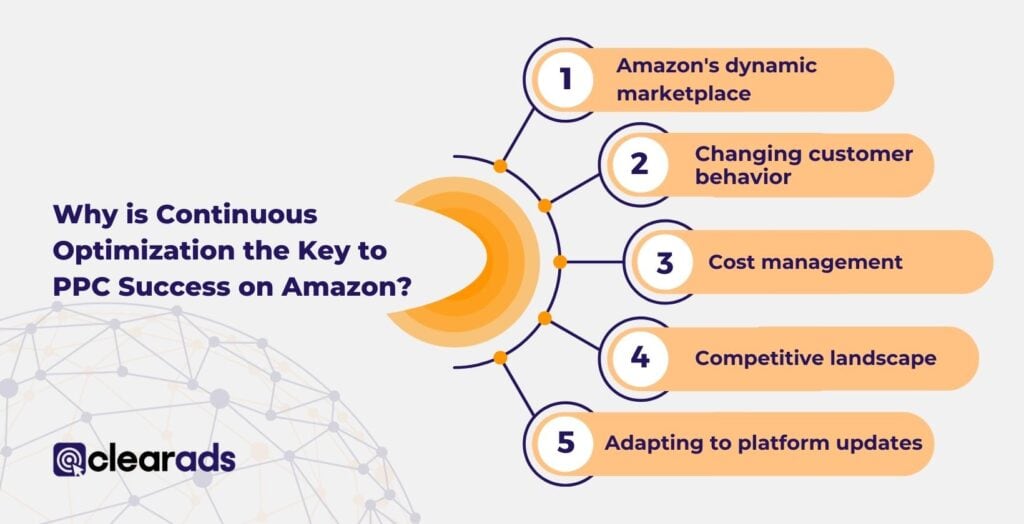
Continuous optimization helps sellers to manage ad spend efficiently, aligns campaigns with set goals, and maintains competitiveness against emerging competitors on the search results page. Depending on campaign types it also allows sellers to build more.
A breakdown of the benefits of continuous optimization:
- Amazon’s dynamic marketplace: Amazon is constantly evolving with new sellers, products, and customer behaviors. Ad campaigns that worked effectively a month ago may not yield the same results today. Regular campaign reviews allow sellers to adapt to these changes, ensuring that their ads remain relevant and effective.
- Changing customer behavior: Customer search patterns, preferences, and behaviors change over time. By continuously optimizing campaigns based on recent data, sellers can ensure they are targeting the most relevant keywords and reaching their desired audience effectively.
- Cost management: Continuous optimization helps in managing ad spend more effectively. By identifying underperforming keywords or ad groups, sellers can reallocate their budget to more profitable areas, ensuring maximum ROI.
- Competitive landscape: The competitive nature of Amazon means that sellers are always competing for the top ad positions. Regular optimization ensures that bids are competitive, and ad placements are optimal. Without continuous adjustments, a seller’s ads might lose visibility, leading to decreased sales and market share.
- Adapting to platform updates: Amazon frequently updates its advertising platform, introducing new features or changing existing ones. Continuous optimization allows sellers to leverage these updates to their advantage, ensuring that their campaigns are always aligned with the platform’s best practices.
- Reactivity to seasonality: Continuous optimization provides the agility to adapt to seasonal trends. For products with seasonal demand, this means being proactive during peak months and adjusting strategies during off-peak times. Without this flexibility, campaigns could overspend or underperform during non-seasonal months, leading to wasted budget and missed opportunities.
Long-term Benefits of an Iterative Approach to PPC Management:
Embracing continuous optimization ensures constant PPC improvement. It drives down the costs of customer acquisition, as ads become more targeted, relevant, and engaging, thus improving conversion rates. Moreover, sellers will better understand the nuances and seasonal trends of their product, whilst also getting more experience with the best-performing campaigns. This knowledge can be used to refine future campaigns, with a lower ACOS and TACOS without the expense of less overall sales.
Continuous optimization contributes to a brand’s longevity on the platform. It helps sellers stay aligned with consumer trends, competitive tactics, and Amazon’s frequent algorithm updates. This alignment is crucial for maintaining visibility and profitability in the long run.
In summary, continuous optimization is not just a best practice but a necessity for Amazon PPC. It ensures that campaigns remain relevant, cost-effective, and competitive, leading to sustained success in the ever-evolving Amazon marketplace.
Conclusion
Effective budgeting and strategic bidding are essential for any seller. Establishing a budget requires understanding core principles, such as historical performance and market dynamics. Sellers must distribute their PPC budget thoughtfully across campaigns, considering factors like past performance and anticipated market shifts. The bidding process on Amazon, whether manual, automated, or dynamic, plays a pivotal role in ad visibility and success. Understanding specific strategies, like Dynamic Bidding’s ‘Down Only’ or ‘Up and Down’, is crucial for optimal results.
Sellers are encouraged to leverage rule-based bidding, consider key metrics like ACOS and TACOS, and optimize bids based on ad placements. Modern technologies, including AI, are reshaping bidding strategies, with various tools available to streamline bid management. Leading brands on Amazon demonstrate agility and continuous optimization, underlining the importance of staying adaptive in the evolving Amazon advertising landscape.
